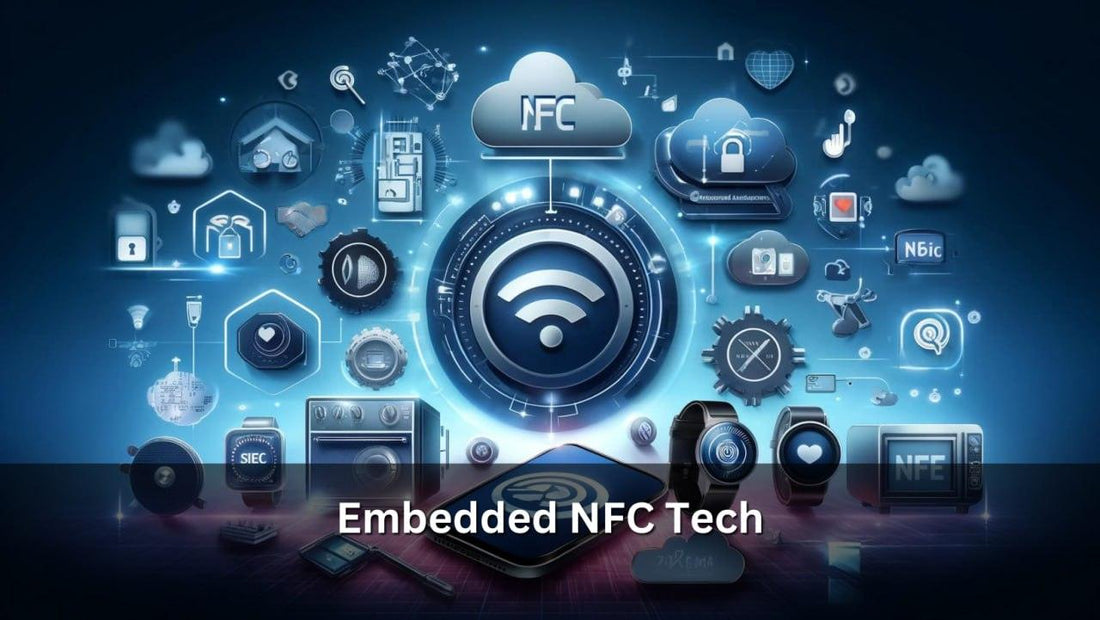Embedded NFC Tech

Contents
- 1- Introduction to NFC for Embedded Applications
- 2- Key Features of NFC Technology
- 3- Advantages of NFC in Embedded Systems
- 4- NFC Principles of Operation
- 5- Applications of NFC in Various Industries
- 6- Security and Privacy with NFC
- 7- Cost Efficiency and Low Power Usage
- 8- Future Prospects of NFC in IoT
- 9- Conclusion
Introduction to NFC for Embedded Applications
Near Field Communication (NFC) is revolutionizing the Internet of Things (IoT) by offering seamless, intuitive, and secure connectivity solutions for embedded systems. As the number of connected devices surges, concerns over data privacy and security are escalating. NFC addresses these issues with its inherently secure communication protocol, which requires close proximity and intent to initiate data exchange, thus significantly reducing the risk of unauthorized access.
NFC operates with minimal power, often harvesting energy from the reading device, which makes it ideal for battery-less or low-power applications. This cost-effective technology is particularly advantageous for smart home devices, healthcare monitoring systems, and various consumer electronics, enabling enhanced user interactions without the need for complex setups or high energy consumption.
With its ease of integration and broad applicability, NFC is poised to become the critical link in connecting the myriad devices that make up the IoT ecosystem, driving forward innovation and convenience in everyday technology.
Key Features of NFC Technology
Near Field Communication (NFC) is a short-range, wireless technology that enables seamless data exchange between devices. One of its primary features is its ability to operate in three distinct modes: Read/Write, Peer-to-Peer, and Card Emulation. In Read/Write mode, an NFC-enabled device can read data from or write data to NFC tags. Peer-to-Peer mode allows two NFC-enabled devices to exchange data directly, facilitating easy file sharing and device pairing. Card Emulation mode transforms an NFC device into a virtual smart card, enabling secure transactions like contactless payments and access control.
NFC's inherent security and privacy come from its limited operational range, typically up to 10 centimeters, which minimizes the risk of unauthorized access. Additionally, NFC can function without a power source by harvesting energy from the interacting device, making it ideal for low-power or battery-less applications. These features make NFC a versatile and cost-effective solution for various embedded applications.
Advantages of NFC in Embedded Systems
NFC technology offers significant advantages for embedded systems, particularly in the realms of cost, power efficiency, and security. One of the most notable benefits is its zero-power operation capability. NFC tags can be powered through energy harvested from the NFC reader's RF field, eliminating the need for batteries and reducing overall power consumption. This makes NFC ideal for IoT devices that require long-lasting, maintenance-free operation.
Additionally, NFC's close-range communication enhances security by minimizing the risk of unauthorized access. Data exchanges occur only when devices are in close proximity, ensuring that sensitive information is protected. The simplicity and ease of use of NFC technology also contribute to reduced design complexity and lower implementation costs. By integrating NFC, manufacturers can offer enhanced user experiences, such as simplified device pairing and seamless data transfer, without the need for extensive power resources or complex setups.

NFC Principles of Operation
Near Field Communication (NFC) operates as a short-range wireless technology designed for simple, intuitive connectivity between devices. It works within a range of up to 10 centimeters, making it secure and user-friendly. NFC communication is established through electromagnetic induction between two NFC-enabled devices, typically a reader and a tag.
NFC functions in three primary modes: Read/Write, Peer-to-Peer, and Card Emulation. In Read/Write mode, an NFC device reads data from or writes data to another NFC tag. Peer-to-Peer mode allows two NFC-enabled devices to exchange data directly, facilitating seamless sharing of information. In Card Emulation mode, an NFC device acts as a contactless smart card, enabling secure transactions such as payments and access control.
The technology's proximity-based operation ensures that interactions are deliberate and secure, reducing the risk of data interception. This makes NFC an ideal choice for applications requiring secure, efficient, and low-power wireless communication.
Applications of NFC in Various Industries
NFC technology is transforming various industries by enabling secure, efficient, and user-friendly interactions. Its applications span from smart homes and consumer electronics to healthcare and retail, enhancing convenience and functionality in everyday life.
Smart Home and Appliances
In smart homes, NFC simplifies the management and control of household devices. For instance, users can tap their smartphones on NFC-enabled thermostats to adjust settings or on washing machines to select and start wash cycles. This interaction eliminates the need for complex interfaces, making home automation more intuitive and accessible. Additionally, NFC tags can store appliance data, providing easy access to maintenance information and user manuals. By integrating NFC, home appliances become more interactive, user-friendly, and capable of personalized operations based on user preferences.
Security and Privacy with NFC
NFC technology offers robust security and privacy features that make it an ideal choice for various applications. One of the primary advantages of NFC is its limited operational range, typically up to 10 centimeters. This close proximity requirement significantly reduces the risk of eavesdropping and unauthorized data access, as interactions occur only when devices are near each other.
Additionally, NFC requires intent-based communication, meaning that both devices must actively participate in the data exchange. This ensures that data transfer is deliberate and secure. NFC also supports advanced encryption protocols and secure elements, such as embedded chips, which safeguard sensitive information during transactions. These features are particularly beneficial for applications like contactless payments, access control, and secure data sharing.
By leveraging these inherent security and privacy advantages, NFC provides a reliable and secure method for wireless communication, protecting user data and ensuring privacy in various embedded applications.
Cost Efficiency and Low Power Usage
NFC technology is renowned for its cost efficiency and low power usage, making it a favorable choice for a wide range of embedded applications. One of the key advantages of NFC is its ability to operate without a dedicated power source. NFC tags can harvest energy from the electromagnetic field generated by the reader, enabling zero-power operation. This feature is particularly useful for battery-less devices, reducing maintenance costs and extending the lifespan of the system.
Additionally, the integration of NFC technology into products is relatively inexpensive compared to other wireless communication methods like Bluetooth or WiFi. NFC chips and tags are cost-effective, which helps in lowering the overall bill of materials for manufacturers. The simplicity of NFC also reduces the complexity of device design and assembly, further driving down costs.
By offering a low-cost, low-power solution, NFC technology enables the development of efficient and sustainable products, making it an attractive option for modern IoT and embedded systems.
Healthcare Applications
In healthcare, NFC enables secure and efficient management of patient data and medical devices. For example, NFC can be used in wearable health monitors to transmit vital statistics to healthcare providers’ smartphones or tablets. This allows for real-time monitoring and reduces the need for manual data entry, improving accuracy and efficiency. NFC can also be used for secure access to medical records, ensuring that only authorized personnel can access sensitive information. By integrating NFC, healthcare facilities can enhance patient care, streamline operations, and maintain high standards of data security.
Future Prospects of NFC in IoT
The future of NFC in the Internet of Things (IoT) is incredibly promising, with its applications expected to expand significantly across various industries. As the IoT ecosystem grows, the need for secure, low-power, and cost-effective communication methods becomes more critical. NFC's unique attributes, such as its ability to operate without a dedicated power source and its inherent security features, make it an ideal solution for these requirements.
In the coming years, we can anticipate NFC being increasingly integrated into smart cities, healthcare systems, and industrial automation. Innovations in NFC technology will likely lead to enhanced interoperability, allowing more devices to communicate seamlessly. Additionally, advancements in energy harvesting and miniaturization will enable NFC to be embedded in even smaller and more diverse devices.
NFC's role in the IoT will continue to evolve, driving new opportunities for smart interactions, improved user experiences, and robust security in a world of interconnected devices.

Conclusion
NFC technology is a game-changer for embedded applications, offering secure, efficient, and low-cost communication solutions. Its inherent advantages, such as zero-power operation, close-range security, and ease of integration, make it ideal for a variety of industries, including smart homes, healthcare, and consumer electronics. As the IoT ecosystem continues to expand, NFC's role in enhancing device connectivity and user interaction will become even more significant. By leveraging NFC, manufacturers can create innovative, user-friendly products that meet the growing demands for seamless, secure, and efficient connectivity in the digital age.










